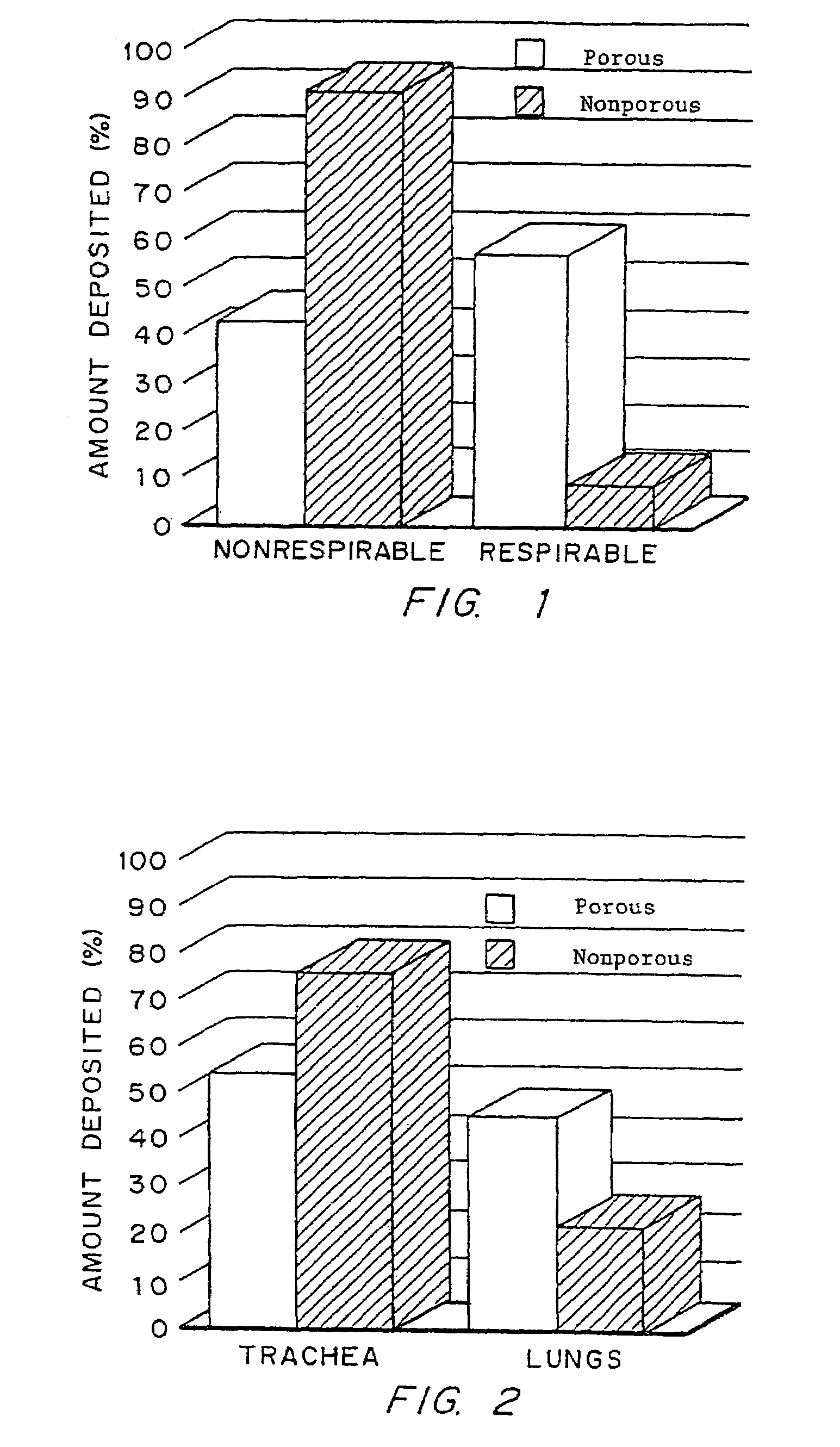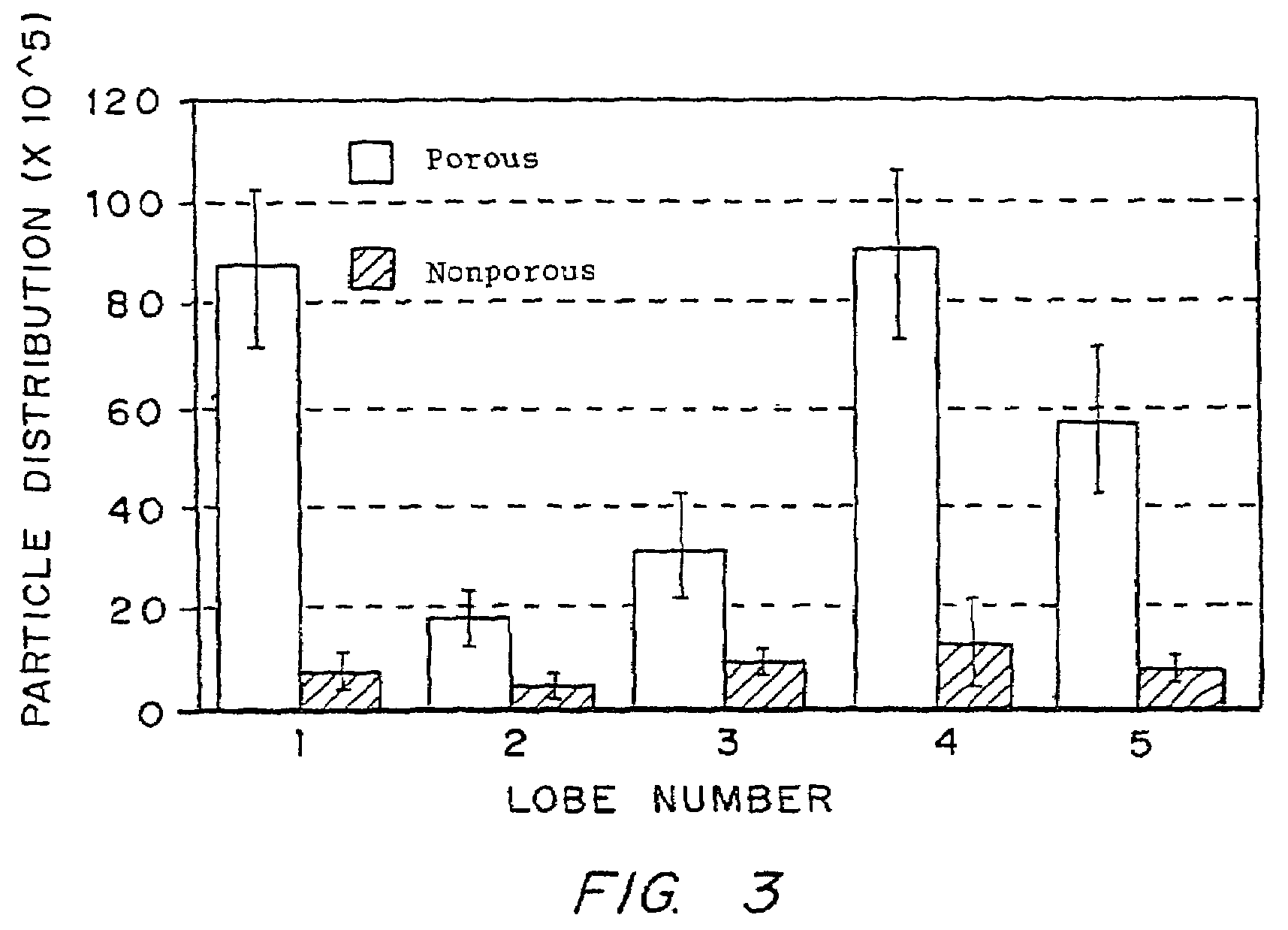Porous particles comprising excipients for deep lung delivery
a technology of porous particles and excipients, applied in the direction of phosphorous compound active ingredients, drug compositions, aerosol delivery, etc., can solve the problems of poor control of the site, excessive loss of inhaled, restricted protein and peptide delivery via degradable particles, etc., to achieve the effect of improving the delivery of a therapeutic agen
- Summary
- Abstract
- Description
- Claims
- Application Information
AI Technical Summary
Benefits of technology
Problems solved by technology
Method used
Image
Examples
example 1
Synthesis of Porous Poly[(p-carboxyphenoxy)-hexane anhydride] (“PCPH”) Particles
[0050]Porous poly[(p-carboxyphenoxy)-hexane anbydride] (“PCPH”) particles were synthesized as follows. 100 mg PCPH (MW-25,000) was dissolved in 3.0 mL methylene chloride. To this clear solution was added 5.0 mL 1w / v aqueous polyvinyl alcohol (PVA, MW .about.25,000, 88 mole % hydrolyzed) saturated with methylene chloride, and the mixture was vortexed (VORTEX GENIE® 2 vortexer from Fisher Scientific) at maximum speed for one minute. The resulting milky-white emulsion was poured into a beaker containing 95 mL 1% PVA and homogenized (Silverson Homogenizers) at 6000 RPM for one minute using a 0.75 inch tip. After homogenization, the mixture was stirred with a magnetic stirring bar and the methylene chloride quickly extracted from the polymer particles by adding 2 mL isopropyl alcohol. The mixture was continued to stir for 35 minutes to allow complete hardening of the microparticles. The hardened particles wer...
example 2
Synthesis of PLAL-Lys and PLAL-Lys-Ala Polymeric and Copolymeric Particles
[0052]Porous PLAL-Lys Particles
[0053]PLAL-Lya particles were prepared by dissolving 50 mg of the graft copolymer in 0.5 ml dimethylsulfoxide, then adding 1.5 ml dichloromethane dropwise. The polymer solution is emulsified in 100 ml of 5% w / v polyvinyl alcohol solution (average molecular weight 25 KDa, 88% hydrolyzed) using a homogenizer (Silverson) at a speed of approximately 7500 rpm. The resulting dispersion is stirred using a magnetic stirrer for 1 hour. Following this period, the pH is brought to 7.0-7.2 by addition of 0.1 N NaOH solution. Stirring is continued for an additional 2 hours until the methylene chloride is completely evaporated and the particles hardened. The particles are then isolated by centrifugation at 4000 rpm (1600 g) for 10 minutes (Sorvall RX-5B). The supernatant is discarded and the precipitate washed three times with distilled water, the dispersion frozen in liquid nitrogen, and lyop...
example 3
Rhodamine Isothiocyanate Labeling of PLAL and PLAL-Lys Particles
[0060]Lysine amine groups on the surface or porous (PLAL-Lys) and nonporous (PLAL) microparticles with similar mean diameters (6-7 μm) and size distributions (standard deviations 3-4 μm) were labeled with Rhodamine isothiaocyanate. The mass density of the porous PLAL-Lys particles was 0.1 g / cm3 and that of the nonporous PLAL particles was 0.8 g / cm3.
[0061]The rhodamine-labeled particles were characterized by confocal microscopy. A limited number of lysine functionalities on the surface of the solid particle were able to react with rhodamine isothiocyanate, as evidenced by the fluorescent image. In the porous particle, the higher lysine content in the graft copolymer and the porous particle structure result in a higher level of rhodamine attachment, with rhodamine attachment dispersed throughout the interstices of the porous structure. This also demonstrates that targeting molecules can be attached to the porous particles...
PUM
| Property | Measurement | Unit |
|---|---|---|
| aerodynamic diameter | aaaaa | aaaaa |
| tap density | aaaaa | aaaaa |
| tap density | aaaaa | aaaaa |
Abstract
Description
Claims
Application Information
 Login to View More
Login to View More - R&D
- Intellectual Property
- Life Sciences
- Materials
- Tech Scout
- Unparalleled Data Quality
- Higher Quality Content
- 60% Fewer Hallucinations
Browse by: Latest US Patents, China's latest patents, Technical Efficacy Thesaurus, Application Domain, Technology Topic, Popular Technical Reports.
© 2025 PatSnap. All rights reserved.Legal|Privacy policy|Modern Slavery Act Transparency Statement|Sitemap|About US| Contact US: help@patsnap.com


